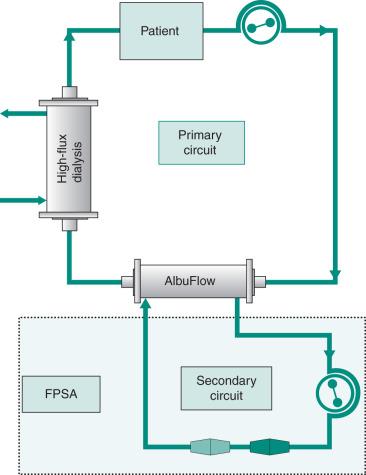Physical Address
304 North Cardinal St.
Dorchester Center, MA 02124
This chapter will:
Provide a description of the Prometheus extracorporeal liver support system.
Summarize available clinical data of Prometheus.
Compare Prometheus with MARS procedures.
Discuss the method, results, and possible indications.
Patients with liver failure still have a high mortality if liver transplantation is not available in time. Therefore extracorporeal liver support devices have already been evaluated for a long time. Of these, bioartificial systems (“bioliver”) contain hepatocytes in a bioreactor, which will replace full liver function. In contrast, artificial systems (“liver dialysis”) aim only at supporting liver detoxification by using different filtration techniques that remove toxic substances. However, a substantial improvement of the patients' outcome could not be demonstrated by any system or method. Over the past 20 years, the field of artificial liver support systems has regained attention as new devices such as the molecular adsorbent recirculating system (MARS, Gambro, Lund, Sweden) were developed. These systems combine the removal of albumin-bound and of water-soluble substances and therefore often are referred to as “albumin dialysis.”
Prometheus (Fresenius Medical Care, Bad Homburg, Germany) is another artificial liver support device based on albumin dialysis. The purification method is called fractionated plasma separation and adsorption (FPSA) and was developed by Falkenhagen et al. The combined removal of albumin-bound substances and water-soluble substances is achieved by a different method than MARS. Although the latter uses an albumin-impermeable membrane and removes toxins by diffusion, Prometheus consists of an albumin-permeable polysulfone membrane (AlbuFlow) that separates the albumin fraction with all bound substances of the patient's blood into the secondary circuit ( Fig. 192.1 ). There, special adsorbers (Prometh01, Prometh02) directly purify the plasma from albumin-bound toxins. Thereafter, water-soluble substances are removed by conventional high-flux-dialysis (FX50) inside the primary circuit. A modified hemodialysis unit (4008H) integrates the two circuits of the Prometheus system, which are run separately by the unit. Thus either conventional hemodialysis alone or hemodialysis with simultaneous albumin detoxification can be performed by the Prometheus system.

At first, anticoagulation during Prometheus liver support consisted of unfractionated heparin. However, a clotting of the secondary circuit was seen in some patients despite close monitoring of anticoagulation. To overcome this potential albumin loss, regional anticoagulation with citrate was established and significantly reduces the number of clotting events. If properly performed, there seems to be no elevated risk of bleeding, hypocalcemia, or acidosis for the patient. Citrate anticoagulation is facilitated by an additional citrate-calcium module that offers automated algorithms.
Become a Clinical Tree membership for Full access and enjoy Unlimited articles
If you are a member. Log in here